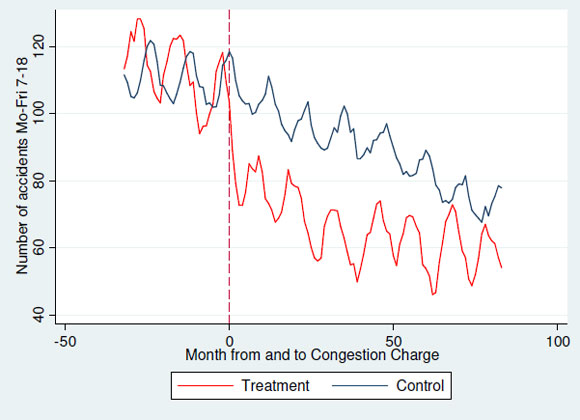
Add street safety to the list of benefits from congestion pricing. That’s the takeaway from a new “working paper” analyzing traffic crash rates in and around the London congestion charging zone by three economists associated with the Management School at Lancaster University.
“Traffic Accidents and the London Congestion Charge” slices and dices the monthly changes in crash frequencies since the 2003 startup of London’s congestion charge in nearly every way imaginable: daytime vs. nighttime (the charge is in effect 7 a.m. – 6:30 p.m.); weekdays vs. weekends (no charge during the latter); within both the 8-square-mile charging zone and each of two “spillover regions” two and four kilometers outside the zone; for charged and exempt road users; for fatal and serious injury crashes and all crashes; and vis-à-vis a control group of 20 other British urban areas. (The comparison group is necessary to control for declining crash rates throughout the U.K.)
The bottom line: Traffic crashes are significantly lower with congestion charging — by as much as 40 percent within the cordon zone. Crashes are down in the spillover regions as well; they declined not only for autos and trucks but for “uncharged” vehicles like taxis, buses, motorbikes and bicycles; and the improvement registered during non-charge times as well as the hours when the congestion charge is collected.
Here are key findings:
- Traffic crashes within the charging zone are down by approximately 400 per year, relative to ongoing trends, corresponding to a 38-40 percent decrease — a reduction several times greater than the drop in vehicle miles traveled.
- Within both spillover zones, crashes are 13-14 percent less than in the control cities, belying fears that rerouting of journeys and/or destinations would merely relocate traffic conflict and danger to areas outside the zone.
- Even with considerable mode-shifting from cars to bicycles, motorcycles and taxis, crash rates for “uncharged” vehicles within the zone are 12 percent below those for the same vehicle classes in the control cities.
- Crash rates inside the zone during non-charge hours are also significantly less than in the control cities, i.e., gains in safety haven’t been confined to the 55-60 hours a week in which congestion is charged but are spread across all 168 hours per week.
- The congestion charge has led to an estimated 46 fewer serious and fatal crashes within the charging zone each year, including 4-5 fewer fatalities per year.
The authors sum up their findings thus:
[W]e have found no evidence of substitution in which uncharged adjacent areas, hours or vehicles have increased accidents as a result of the congestion charge. Instead, the influence of the congestion charge appears substantially larger than would be indicated by limiting the analysis to the zone, time and vehicles directly charged. . . Thus, there seems to have been a more general and fundamental change in the number of trips and/or mode of transportation.
While this summation is satisfying for being so robust, it omits a tantalizing hypothesis related to a possible experiential change on London’s streets and roads. Could it be that the net drop in vehicle miles traveled and the corresponding decrease in “exposure” due to London’s congestion charge is being enhanced by a change in the character of urban driving? Perhaps the greater predictability of auto trips — not just quicker journeys but fewer unnerving standstills — enables a more relaxed approach to driving that translates into attentiveness, consideration, and due care.
That is speculation. What’s beyond speculation are the robust and multi-dimensional declines in crashes over the dozen years of London’s charging scheme. The findings of the paper, which is to be presented in final form later this month at the Royal Economic Society, prompted former NYC DOT Commissioner Janette Sadik-Khan to hail London congestion charging as “one of the great road safety success stories.”
So far as New York City is concerned, the paper should dispel the notion that the higher traffic speeds promised by the Move NY toll-reform plan will make crashes more common or injurious; after all, the plan’s anticipated boost to CBD 24-hour average driving speeds, from the current 10 mph to nearly 12, corresponds more to smoothing traffic than accelerating it. With London’s congestion pricing safety dividend convincingly confirmed, Move NY and Vision Zero are squarely on the same team.





